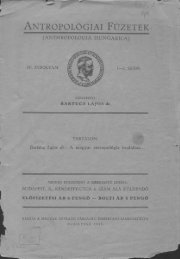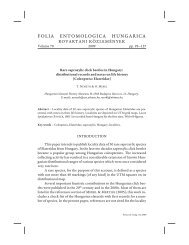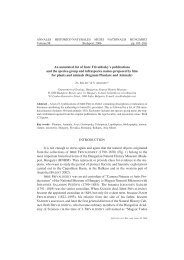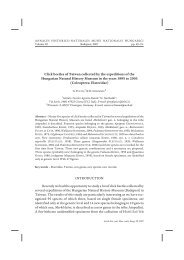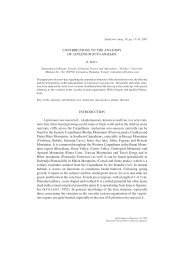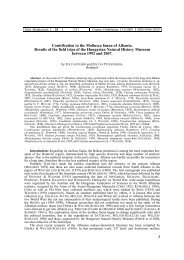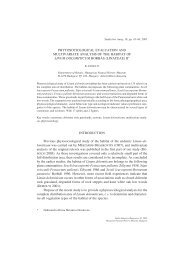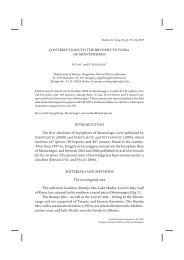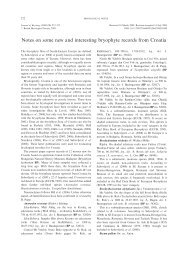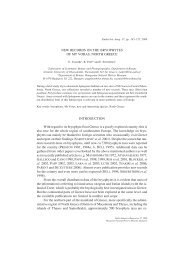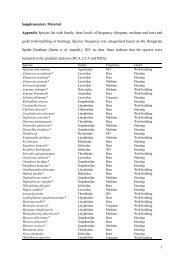THE GENUS SCHISTIDIUM (GRIMMIACEAE, MUSCI) IN HUNGARY ...
THE GENUS SCHISTIDIUM (GRIMMIACEAE, MUSCI) IN HUNGARY ...
THE GENUS SCHISTIDIUM (GRIMMIACEAE, MUSCI) IN HUNGARY ...
Create successful ePaper yourself
Turn your PDF publications into a flip-book with our unique Google optimized e-Paper software.
<strong>THE</strong> <strong>GENUS</strong> <strong>SCHISTIDIUM</strong> <strong>IN</strong> <strong>HUNGARY</strong> 61<br />
prope Kesztölc, 450 m, 14.04.1946, leg. Á. Boros, BP 111736; : Com.<br />
Pest. In rupibus calcareis montis Telkihegy prope pag. Telki, 22.03.1948, leg. L. Vajda, BP<br />
58480; : Comit. Esztergom. In rupibus calcareis montis Öregkõ<br />
prope Bajót, 300–375 m, 05.04.1936, leg. Á. Boros, BP 110846; : Csákberény,<br />
Ugró-völgy, auf w-exponierten, besonnten niedrigen Dolomitfelsen, 29.04.2001,<br />
leg. P. Erzberger, herb. Erzberger, (B) 7081; : Comit. Baranya. In<br />
rupibus calcar. merid. montis Tubes prope Pécs, 600 m, 26.04.1962, leg. Á. Boros, BP<br />
111398; : Comit. Baranya. In rupestribus calcar. montis Tenkes-hegy<br />
prope Máriagyüd, 300–400 m, 17.04.1942, leg. Á. Boros, BP 111384.<br />
(Kindb.) H. H. Blom<br />
(Figs 23, 24)<br />
Plants small to medium-sized, forming lax tufts. Central strand absent or indistinct.<br />
Hair-point short or absent, 0–0.3 mm, decurrent, sharply and strongly spinulose-denticulate.<br />
Costa distantly papillose in upper (1/2–)2/3–4/5 of the leaf length with papillae increasing<br />
in height towards the leaf apex (about 8 μm wide and 9–11 μm high in apical part).<br />
Margins irregular dentate in upper part with teeth pointing in various directions. Lamina<br />
unistratose, smooth or rarely with few papillae on the abaxial side near apex. Lamina cells<br />
sinuose, 7–10 μm wide in upper part, (8–)9–10 μm wide in lower parts of leaf. K+ red.<br />
Sporophytes usually present, mostly shallowly immersed and much exposed in lateral<br />
view. Urn dark red to reddish-brown, small, 0.7–0.85–1 mm long, length / width ratio<br />
1.3–1.5–1.7 (BLOM 1996), in Hungarian material (0.9–)1.3 ±0.08(–1.6), n = 33. Exothecial<br />
cells thin-walled, short transversely rectangular and isodiametric, square, arranged in<br />
regular perpendicular rows (Figs 1F, G, 23G–I). Stomata large, 6–10 per urn. Peristome<br />
teeth 320–400 μm, orange, semi-perforated in lower part, from almost entire to strongly<br />
perforated in upper part.<br />
Usually an easily known plant with a unique combination of apically papillose costa<br />
and margins, with the size of papillae increasing towards the apex (Fig. 23B, C) and small<br />
capsules exhibiting a characteristic pattern of exothecial cells. In moist shaded habitats,<br />
costal papillae may be confined to the apical part of the leaf. S. apocarpum differs from S.<br />
lancifolium by its larger size in nearly all aspects (leaf length, width, urn length, width, peristome<br />
teeth length – compare Figs 4 and 23), but there is a small overlap in these quantitative<br />
characters.<br />
In Hungary, S. lancifolium is a typical plant of shaded andesite rocks, with a preference<br />
for higher altitudes. In Scandinavia, this species is an early pioneer on dry acidic to<br />
slightly basic (typically greenstone, but very occasionally also limestone) cliffs and boulders<br />
in relatively dense and moist forests (WEIBULL 2006).<br />
: On shaded siliceous (andesite, porphyric rock, slate, sandstone) or more<br />
rarely calcareous rock (dolomite), often near streams or flushes and in ravines, in forests,<br />
preferably, but not exclusively at higher altitude (700–900 m).<br />
Studia bot. hung. 39, 2008



